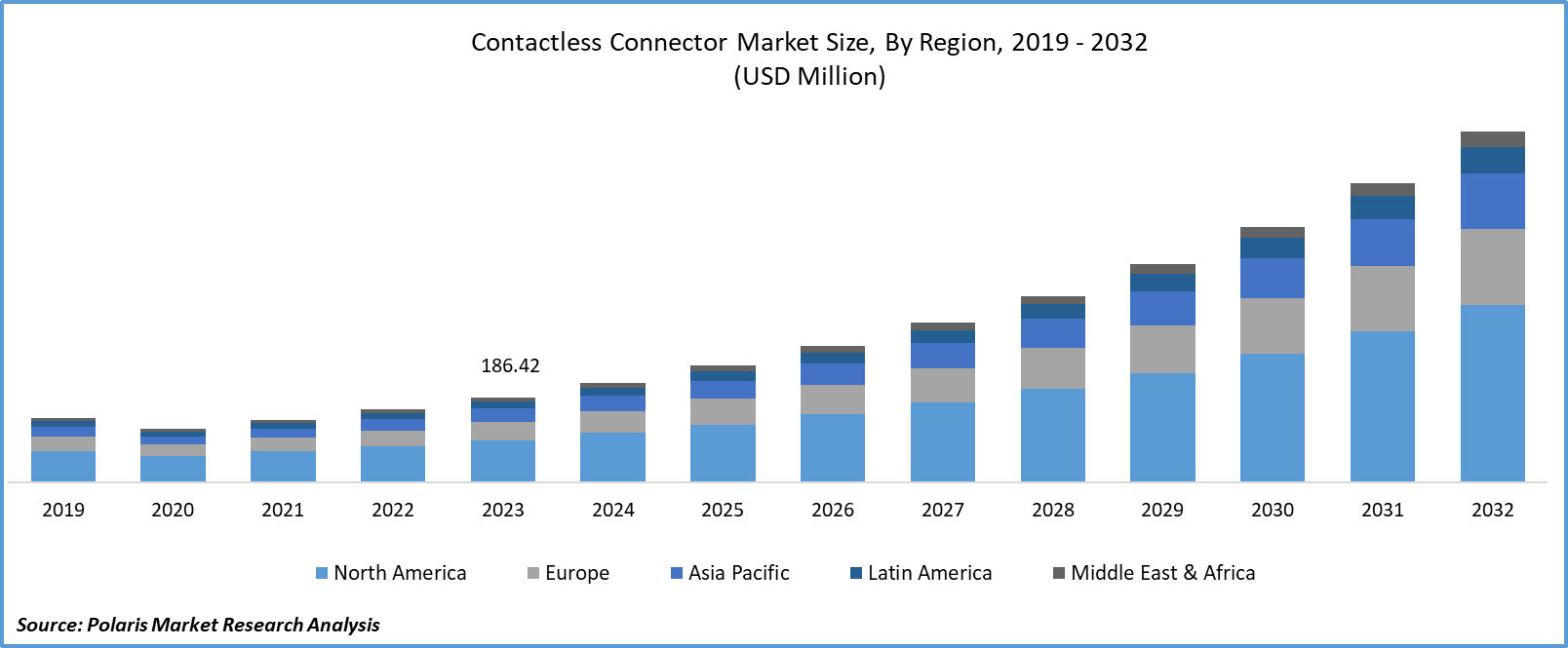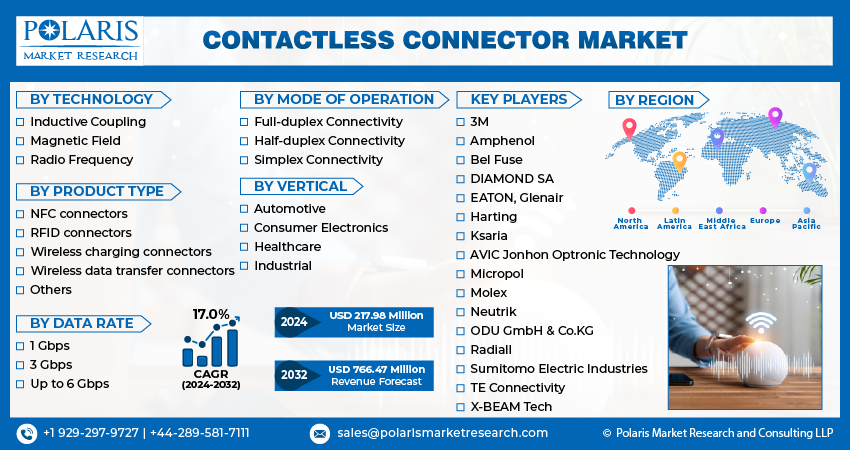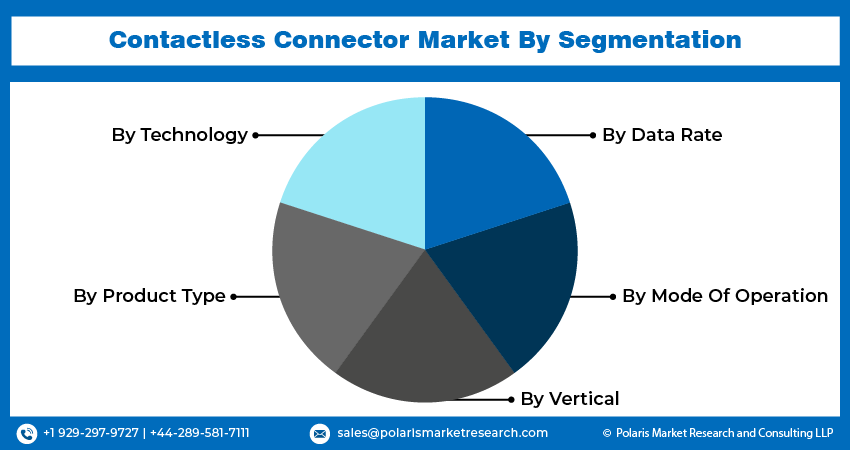
Contactless Connector Market Share, Size, Trends, Industry Analysis Report, By Technology (Inductive Coupling, Magnetic Field, Radio Frequency); By Product Type; By Data Rate; By Mode Of Operation; By Vertical; By Region; Segment Forecast, 2024- 2032
- Published Date:Mar-2024
- Pages: 116
- Format: PDF
- Report ID: PM4706
- Base Year: 2023
- Historical Data: 2019-2022
Report Outlook
Global contactless connector market size was valued at USD 186.42 million in 2023. The market is anticipated to grow from USD 217.98 million in 2024 to USD 766.47 million by 2032, exhibiting the CAGR of 17.0% during the forecast period.
Industry Trends
Contactless connectivity is a burgeoning technology with several early applications, including USB SuperSpeed, Gigabit Ethernet, DisplayPort, PROFINET, EtherCAT, and single-pair Ethernet (SPE). These contactless connectors, which are specialized mmWave transceivers, serve as substitutes for conventional wired connectors. They facilitate cable-free, high-speed connections between closely spaced devices, typically up to a few centimeters apart.
The global contactless connector market pertains to the development, production, and dissemination of contactless connectors for diverse electronic applications. These connectors employ technologies like RFID, NFC, and wireless charging to establish connections sans physical contact, enhancing convenience, efficiency, and security across industries such as consumer electronics, automotive, healthcare, and industrial automation. Contactless connectors offer benefits like minimized wear, heightened reliability, and increased resilience against environmental elements such as moisture, dust, and vibration. They find extensive usage in smartphones, payment terminals, smartwatches, access control systems, wearables, and IoT devices, among other applications; this results in increasing contactless connectivity market share in the upcoming years.

To Understand More About this Research: Request a Free Sample Report
With the rise of automation, industrial plants are increasingly interconnecting electromechanical systems. This heightened connectivity often strains cables and plug contacts, leading to cable deterioration or breakage and plug contact failures, resulting in machine downtime. Contactless transmission presents a solution by eliminating the need for rigid electromechanical couplings. Instead, radio technology offers significant flexibility, reducing the risk of cable damage and plug contact wear. This flexibility enhances the overall reliability and efficiency of industrial operations.
The proliferation of Internet of Things (IoT) devices across sectors such as smart homes, automotive, healthcare, and industrial automation fuels the demand for contactless connectors. These connectors facilitate seamless connectivity and communication between IoT devices, enabling efficient data exchange and automation, thereby increasing The growth of the contactless connector market share.
However, the growing trend towards automation in industries necessitates reliable and efficient connectivity solutions. Contactless connectors have advantages such as improved reliability, Less wear and tear, and enhanced resistance to environmental factors, making them ideal for use in industrial automation applications. As industries continue to automate processes, the demand for contactless connectors is expected to surge. The expanding market for consumer electronics, including smartphones, wearables, and smart home devices, drives the demand for contactless connectors. These connectors enable the development of sleeker, more compact devices by eliminating the need for physical connectors and cables, thereby enhancing consumer experience and driving market growth. The expanding market for consumer electronics, including smartphones, wearables, and smart home devices, drives the demand for contactless connectors.
Contactless connectors have applications across a wide range of industries beyond their traditional uses in consumer electronics and industrial automation. Opportunities exist for market players to expand into sectors such as healthcare, transportation, smart cities, and agriculture, where the benefits of contactless connectivity can be leveraged to improve efficiency, reliability, and convenience.

Key Takeaways
- North America dominated the largest market and contributed to more than 38% of share in 2023.
- Asia Pacific is expected to grow at the fastest CAGR during the forecast period.
- By technology category, the wireless charging connectors segment anticipated to grow at the highest CAGR during the forecast period.
- By Vertical category, Consumer Electronics segment expected to grow at the fastest CAGR during the forecast period.
What are the market drivers driving the demand for Contactless Connector Market?
Increasing technological advancement is projected to spur product demand.
Contactless connectivity revolutionizes the design and functionality of electronic devices by significantly reducing reliance on cables, wiring, and physical connectors integrated into printed circuit boards (PCBs). This innovative approach yields sleeker, more compact, and lighter-weight device designs, marking a departure from conventional bulkier setups. Moreover, contactless technology eliminates the necessity for diagnostic ports, further refining device aesthetics and functionality.
The sealed nature of contactless connectors renders them highly suitable for deployment in demanding environments characterized by dust, dirt, and moisture, ensuring reliable performance even in adverse conditions. These connectors boast versatile temperature ratings, ranging from 0°C to +70°C for commercial applications and extended ranges such as -30°C to +85°C, enabling operation across a wide spectrum of environmental conditions. Their robust construction mitigates the impact of vibrations and mechanical stresses, enhancing overall durability and longevity.
Notably, the adoption of contactless connectors also enhances manufacturability, production speed, configurability, and testability of electronic devices. By eliminating the need for attaching physical connectors, the manufacturing process becomes more streamlined and efficient, resulting in accelerated production timelines and greater flexibility in device configurations. Additionally, the absence of physical connectors simplifies testing procedures, leading to improved quality control and reduced testing overheads.
Which factor is restraining the demand for the Contactless Connector?
High cost, compatibility and range limitation may likely impede the market growth.
The initial investment required for integrating contactless connector technology into existing systems often surpasses the costs associated with traditional wired connectors. This financial barrier can dissuade adoption, particularly for businesses operating within constrained budgets. Furthermore, the compatibility of contactless connectors with pre-existing infrastructure and devices poses a significant challenge. In many cases, the deployment of contactless technology necessitates upgrades or replacements to ensure seamless integration, adding further to the investment burden. These compatibility hurdles impede the swift adoption of contactless connectors and impinge upon market expansion.
Additionally, the inherent range limitations of contactless connections present another obstacle to widespread adoption. Unlike wired connectors, contactless connections typically operate over shorter distances. Consequently, scenarios requiring communication across longer distances may find contactless connectors unsuitable, further constraining their applicability. This limitation hampers the versatility and potential use cases of contactless technology, thereby hindering its broader adoption across various industries and applications.
Report Segmentation
The market is primarily segmented based on technology, product type, data rate, mode of operation, vertical and region.
|
By Technology |
By Product Type |
By Data Rate |
By Mode Of Operation |
By Vertical |
By Region |
|
|
|
|
|
|
To Understand the Scope of this Report: Speak to Analyst
Category Wise Insights
By Technology Insights
Based on technology analysis, the market is segmented on the basis of NFC connectors, RFID connectors, wireless charging connectors, wireless data transfer connectors, and others. The Wireless charging connectors segment is anticipated to grow at the highest CAGR during the forecast period. The rapid expansion of smart home devices and IoT gadgets presents a ripe opportunity for the integration of wireless charging connectors. As the ecosystem of connected devices continues to grow both in residential and commercial settings, there arises an increasing demand for charging solutions that offer seamless convenience and versatility. With households and workplaces now accommodating a multitude of connected devices, ranging from smartphones and tablets to smart speakers and wearables, there is a pressing need for charging solutions that can cater to multiple devices simultaneously without the hassle of cables and plugs.
This surge in demand for efficient and user-friendly charging solutions propels the growth of wireless charging connectors. These connectors enable users to power up their devices effortlessly, eliminating the clutter of cables and streamlining the charging process. Whether it's charging smartphones, tablets, laptops, or IoT sensors, wireless charging connectors offer a convenient and hassle-free solution that aligns with the evolving needs of modern consumers and businesses.
Furthermore, the increasing popularity and adoption of smart devices across various domains play a pivotal role in driving the uptake of wireless charging technology. The growing reliance on wireless charging not only underscores the importance of seamless connectivity but also underscores the pivotal role that wireless charging connectors play in facilitating this transition toward a more connected and convenient future.
By Vertical Insights
Based on vertical analysis, the market has been segmented based on automotive, consumer electronics, healthcare, and industrial. The consumer electronics segment is expected to grow at the fastest CAGR during the forecast period. The rapid pace of technological advancement within the contactless connector market is driving significant growth and innovation within the consumer electronics sector. These advancements are revolutionizing the way consumers interact with their electronic devices, enhancing user experiences and opening up new possibilities for manufacturers. One key area of advancement lies in the improvement of data transfer speeds. As consumers increasingly demand faster and more efficient connectivity, contactless connectors are evolving to support higher data transfer rates, enabling seamless streaming, downloading, and sharing of multimedia content. Operational efficiency is another focal point of innovation. Contactless connectors are being designed to optimize power usage, minimize latency, and improve overall performance, resulting in smoother and more responsive user experiences.
Reliability is a crucial factor in consumer electronics, and contactless connectors are being engineered to deliver heightened reliability and stability. This includes robust signal transmission, resistance to interference, and durability under various environmental conditions, ensuring uninterrupted connectivity and functionality. Compatibility is also a significant area of advancement. As consumers own an array of electronic devices from different manufacturers, contactless connectors are being made more versatile and interoperable, enabling seamless connectivity across a diverse ecosystem of devices.
In response to consumer preferences, manufacturers are focusing on developing high-performance and user-friendly solutions such as wireless charging, seamless data transfer, and compact designs. Contactless connectors play a pivotal role in enabling these features, offering consumers greater convenience, flexibility, and freedom in how they use their devices.

Regional Insights
North America
The North America region dominated the global market with the largest market share in 2023 and is expected to maintain its dominance over the anticipated period. North America boasts a mature and sophisticated market ecosystem, with established industries and a strong emphasis on innovation and technological advancement. The region is home to numerous leading companies in various sectors, including consumer electronics, automotive, healthcare, and industrial automation, which drive demand for contactless connectors.
However, North America has a high level of consumer adoption and acceptance of new technologies, making it a fertile ground for the rapid uptake of contactless connector solutions. Consumers in the region are often early adopters of innovative products and services, leading to a swift integration of contactless connectivity features into a wide range of electronic devices.
Asia Pacific
The Asia Pacific region is expected to experience the fastest compound annual growth rate (CAGR) during the projected period. This is due to several reasons. First, the region includes some of the world's fastest-growing economies, such as China, India, Japan, South Korea, and Southeast Asian countries. These nations are undergoing rapid industrialization, urbanization, and digital transformation, which is driving demand for contactless connector solutions across various industries, including consumer electronics, automotive, telecommunications, and manufacturing. Another factor is the region's large and increasingly affluent population, which is characterized by a rising middle class with greater purchasing power and a growing preference for consumer electronics and smart devices. As disposable incomes continue to rise and lifestyles become increasingly digital-centric, there is an increased need for contactless connectivity solutions that are convenient, efficient, and offer seamless user experiences.
Furthermore, the Asia Pacific region is witnessing significant investments in infrastructure development, particularly in telecommunications networks and smart city initiatives. These investments are driving the deployment of IoT devices, connected sensors, and automation systems, creating additional opportunities for the adoption of contactless connector solutions to enable seamless connectivity and data exchange.

Competitive Landscape
The Contactless Connector Market exhibits fragmentation, poised for heightened competition owing to the presence of numerous players. Anticipated growth in the Contactless Connector Market is fueled by major industry players' substantial R&D investments aimed at expanding their product offerings. Noteworthy market advancements encompass the introduction of innovative products, sizable mergers and acquisitions, contractual collaborations, and strategic partnerships with other entities. Market participants actively engage in these initiatives to fortify their market positions.
Some of the major players operating in the global market include:
- 3M
- Amphenol
- AVIC Jonhon Optronic Technology
- Bel Fuse
- DIAMOND SA
- EATON
- Glenair
- Harting
- Ksaria
- Micropol
- Molex
- Neutrik
- ODU GmbH & Co.KG
- Radiall
- Sumitomo Electric Industries
- TE Connectivity
- X-BEAM Tech
Recent Developments
- In September 2023, Molex unveiled the MX60 series, a lineup of contactless connectivity solutions. These cutting-edge devices boast miniaturized mmWave RF transceivers and integrated antennas within a single package. Offering low-power consumption and high-speed performance, they facilitate seamless device-to-device communication without the need for physical cables or connectors, streamlining the connectivity process significantly.
Report Coverage
The Contactless Connector Market report emphasizes key regions across the globe to provide a better understanding of the product to the users. Also, the report provides market insights into recent developments, and trends and analyzes the technologies that are gaining traction around the globe. Furthermore, the report covers an in-depth qualitative analysis about various paradigm shifts associated with the transformation of these technology
The report provides detailed analysis of the market while focusing on various key aspects such as competitive analysis, technology, product type, data rate, mode of operation, vertical, and their futuristic growth opportunities.
Contactless Connector Market Report Scope
|
Report Attributes |
Details |
|
Market size value in 2024 |
USD 217.98 million |
|
Revenue forecast in 2032 |
USD 766.47 million |
|
CAGR |
17.0% from 2024 – 2032 |
|
Base year |
2023 |
|
Historical data |
2019 – 2022 |
|
Forecast period |
2024 – 2032 |
|
Quantitative units |
Revenue in USD million and CAGR from 2024 to 2032 |
|
Segments covered |
By Technology, By Product Type, By Data Rate, By Mode of Operation, By Vertical. By Region |
|
Regional scope |
North America, Europe, Asia Pacific, Latin America; Middle East & Africa |
|
Customization |
Report customization as per your requirements with respect to countries, region and segmentation. |
FAQ's
The Contactless Connector Market report covering key segments are technology, product type, data rate, mode of operation, vertical and region.
Contactless Connector Market Size Worth $766.47 Million By 2032
Contactless Connector Market exhibiting the CAGR of 17.0% during the forecast period.
North America is leading the global market
key driving factors in Contactless Connector Market are increasing technological advancement is projected to spur product demand
